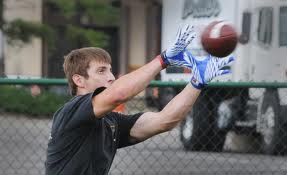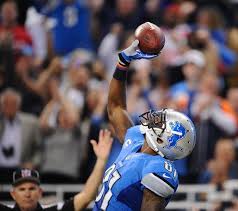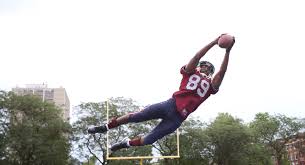To
catch a football the receiver or defender must use
hand-eye coordination. According to wikipedia.org, "Is
the coordinated control of eye movement with hand
movement, and the process of virtual input to guide
reaching and grasping along with the use of
preprioception of the hands to guide the eyes." Hand-eye
coordination involves the eye zoning in on a target and
letting the hands know the shape and other
characteristics of the object. In the case of football,
high hand-eye coordination is needed to be able to catch
a football no matter what position the receiver or
defender is in. The receiver has to judge how high the
ball is, how far they need to run, or whether they need
to dive with their eyes. Then in the same process they
need to be able to get there hands up to catch the
football and they do all of this while running several
different routes every game. Hand-Eye coordination for
football players and for all athletes tends to become
more muscle memory than physics, but with all things the
players must realize the physics behind the sport they
play. To understand this more, a video with NFL player
Larry Fitzgerald is in the slide entitled, Larry
Fitzgerald - Catching Upside Down.



http://udquickly.udayton.edu/snapshots/2011/08/hand-eye-coordination/, http://bendernation.com/calvinjohnson, http://www.theadrenalist.com/sports/football-training-player-position-drills-and-exercises/
In addition to hand-eye coordination, players must be able to bring the kinematic and potential energy to the same amount they were when they left the Quarterbacks hand. If they are unable to do this, the football might simply bounce off there hands and be caught by someone else. Majority of receivers are able to transfer to take this energy in and continue to run down the field and keep moving.
In conclusion, between kinetic/potential energy, kinematic equations, hand-eye coordination, and the many other physics related aspects in football. The game of American Football must have been created by a Physicist because it has different topics for physicist to read about, learn about, and learn to understand more about as time goes on.
Introduction Slide Bibliography Beginning Larry FitzGerald - Upside Down Catching



http://udquickly.udayton.edu/snapshots/2011/08/hand-eye-coordination/, http://bendernation.com/calvinjohnson, http://www.theadrenalist.com/sports/football-training-player-position-drills-and-exercises/
In addition to hand-eye coordination, players must be able to bring the kinematic and potential energy to the same amount they were when they left the Quarterbacks hand. If they are unable to do this, the football might simply bounce off there hands and be caught by someone else. Majority of receivers are able to transfer to take this energy in and continue to run down the field and keep moving.
In conclusion, between kinetic/potential energy, kinematic equations, hand-eye coordination, and the many other physics related aspects in football. The game of American Football must have been created by a Physicist because it has different topics for physicist to read about, learn about, and learn to understand more about as time goes on.
Introduction Slide Bibliography Beginning Larry FitzGerald - Upside Down Catching